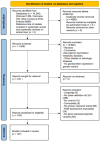Molecular Processes in Stress Urinary Incontinence: A Systematic Review of Human and Animal Studies
- PMID: 35328824
- PMCID: PMC8949972
- DOI: 10.3390/ijms23063401
Molecular Processes in Stress Urinary Incontinence: A Systematic Review of Human and Animal Studies
Abstract
Stress urinary incontinence (SUI) is a common and burdensome condition. Because of the large knowledge gap around the molecular processes involved in its pathophysiology, the aim of this review was to provide a systematic overview of genetic variants, gene and protein expression changes related to SUI in human and animal studies. On 5 January 2021, a systematic search was performed in Pubmed, Embase, Web of Science, and the Cochrane library. The screening process and quality assessment were performed in duplicate, using predefined inclusion criteria and different quality assessment tools for human and animal studies respectively. The extracted data were grouped in themes per outcome measure, according to their functions in cellular processes, and synthesized in a narrative review. Finally, 107 studies were included, of which 35 used animal models (rats and mice). Resulting from the most examined processes, the evidence suggests that SUI is associated with altered extracellular matrix metabolism, estrogen receptors, oxidative stress, apoptosis, inflammation, neurodegenerative processes, and muscle cell differentiation and contractility. Due to heterogeneity in the studies (e.g., in examined tissues), the precise contribution of the associated genes and proteins in relation to SUI pathophysiology remained unclear. Future research should focus on possible contributors to these alterations.
Keywords: associated genes; associated proteins; gene expression; genetic variants; molecular background; protein expression; stress urinary incontinence.
Conflict of interest statement
The authors declare no conflict of interest. The funders had no role in the design of the study; in the collection, analyses, or interpretation of data; in the writing of the manuscript, or in the decision to publish the results.
Figures









References
-
- Groutz A., Gordon D., Keidar R., Lessing J.B., Wolman I., David M.P., Chen B. Stress urinary incontinence: Prevalence among nulliparous compared with primiparous and grand multiparous premenopausal women. Neurourol. Urodyn. 1999;18:419–425. doi: 10.1002/(SICI)1520-6777(1999)18:5<419::AID-NAU2>3.0.CO;2-Z. - DOI - PubMed
-
- Haylen B.T., de Ridder D., Freeman R.M., Swift S.E., Berghmans B., Lee J., Monga A., Petri E., Rizk D.E., Sand P.K., et al. An International Urogynecological Association (IUGA)/International Continence Society (ICS) joint report on the terminology for female pelvic floor dysfunction. Neurourol. Urodyn. 2010;29:4–20. doi: 10.1002/nau.20798. - DOI - PubMed
-
- Irwin D.E., Milsom I., Hunskaar S., Reilly K., Kopp Z., Herschorn S., Coyne K., Kelleher C., Hampel C., Artibani W., et al. Population-based survey of urinary incontinence, overactive bladder, and other lower urinary tract symptoms in five countries: Results of the EPIC study. Eur. Urol. 2006;50:1306–1314. doi: 10.1016/j.eururo.2006.09.019. discussion 1314–1305. - DOI - PubMed
Publication types
MeSH terms
Grants and funding
LinkOut - more resources
Full Text Sources
Medical
Miscellaneous

